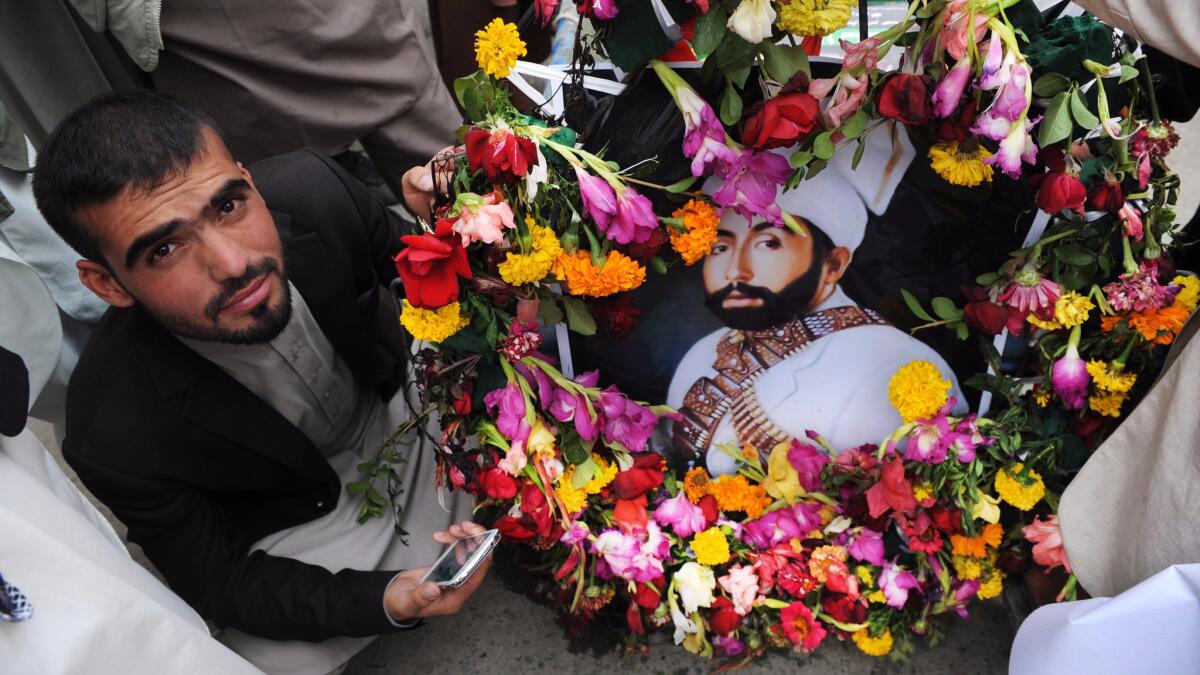How a burial ceremony in Kabul turned deadly, illustrating Afghanistan’s political crisis

A burial ceremony for a former Afghan ruler this week resulted in more death, laying bare deepening ethnic and political fissures inside Afghanistan’s troubled government.
One person was killed and four injured when followers of the ethnic Tajik King Habibullah Kalakani, who briefly held the Afghan throne nearly 90 years ago, attempted to move his burial site.
For the record:
3:22 p.m. April 24, 2024This article originally referred to Mohammad Mohaqiq as “a second vice president” in the unity government. It has been corrected to say he is a deputy to chief executive Abdullah.
But the hilltop they chose is revered by another ethnic group, the Uzbeks, setting off a clash between rival armed factions that required the intervention of senior Afghan officials late Thursday to prevent wider bloodshed.
By Friday morning, the king’s remains had been buried on Shahr Ara hill, named for the daughter of 16th century conqueror Babur, whom the Uzbeks regard as a hero. Kalakani’s followers arrived to pray at the freshly dug grave.
The dispute illustrated the divisions in Afghanistan’s unwieldy coalition government, a U.S.-brokered arrangement that is struggling to hold together after two years.
The controversy began when followers of Kalakani announced plans to move his remains from an unmarked grave. They said he had not been afforded the royal burial he deserved after being killed in 1929 by followers of Nadir Khan, an ethnic Pashtun, who succeeded him as king.
“As each Afghan citizen has the right to live as their natural right, so they have the right to have a grave,” said Yunes Qanuni, a former vice president and member of a commission supporting Kalakani’s reburial.
Abdullah Abdullah, chief executive of Afghanistan’s unity government, issued a decree that Kalakani’s bones should be interred on Shahr Ara.
That prompted opposition from another member of the government, First Vice President Abdul Rashid Dostum, an Uzbek who said the hilltop could not be used because it was a historic site where Babur’s relatives had built a garden.
Standing in front of his residence in Kabul, Dostum, a powerful militia leader who has hordes of armed men under his command, said Thursday there were several other hills that Kalakani’s followers could choose from.
“Why should our history be sacrificed by being destroyed for his graveyard?” Dostum said.
Still, Kalakani’s supporters proceeded with their plans Thursday, removing his bones from the unmarked grave, holding a funeral service and moving toward Shahr Ara with his remains and those of several followers.
“The Afghan people have decided to mark history one more time, a history without falsehood,” said Dawood Kalakani, a member of the reburial commission.
Backing them, dozens of armed militiamen led by former commanders loyal to Abdullah took to the streets of Kabul, some riding in the backs of trucks and toting weapons. The presence of irregular fighters stoked fear across the capital.
About 200 security forces from the Afghan intelligence service who guard Dostum took up positions on the hilltop. Pashtun militiamen offered their support to Dostum.
The factionalism renewed memories of Afghanistan’s long-running ethnic conflicts, which culminated in a 1990s civil war that ended when the Taliban came to power in 1996.
The ethnic rivalries have flared again under President Ashraf Ghani’s unity government, which is struggling to contain Taliban insurgents and shore up the economy, while facing growing tension among ethnic leaders who hold top positions.
Abdullah has been openly critical of Ghani’s leadership in recent weeks. Dostum’s supporters believe the reburial was a deliberate attempt to embarrass Ghani’s government, while analysts say Pashtuns, Afghanistan’s largest ethnic group, of which Ghani is a member, have exploited the tensions between Uzbeks and Tajiks in an attempt to weaken both sides.
“The reburial ceremony has taken a political shape,” said Enayatullah Farahmand, Dostum’s chief of staff. “Making a new history shouldn’t destroy the bigger history of this land.”
Afghan commandos were dispatched to try to restore order, blocking the roads leading to the hilltop. But the commandos let Kalakani’s supporters through, allowing them to move up the hill — where they came face-to-face with Dostum’s forces.
As the confrontation drew near, residents around Shahr Ara hill closed their businesses and shut their gates.
Abdul Ghafar, 63, who closed his shop and was bicycling away from the neighborhood on Thursday, said, “It’s not safe here.
“We are all afraid of the situation and I hope the civil war won’t happen again.”
On the hilltop Thursday evening, it was not clear which side opened fire first. But a clash that lasted about an hour and a half left one person dead – a member of the security forces from Dostum’s side – and four wounded.
When the fighting died down Thursday night, Afghan commandos managed a compromise: Kalakani’s supporters, working by flashlight, buried his remains and those of several followers on the hill, but not in the historic compound.
After the incident, senior Afghan security officials, Kalakani’s supporters and others visited Dostum at his home. On Friday, an agreement was announced that could calm tensions for the moment.
Mohammad Mohaqiq, a deputy to chief executive Abdullah in the unity government and a leader of the Hazara ethnic minority, said the hill’s name would remain unchanged. The Afghan government would restore the garden and build a madrasa named for Kalakani in a location to be determined.
Special correspondent Faizy reported from Kabul and Times staff writer Bengali from Mumbai, India.
Follow @SBengali on Twitter for more news from South Asia
More to Read
Start your day right
Sign up for Essential California for news, features and recommendations from the L.A. Times and beyond in your inbox six days a week.
You may occasionally receive promotional content from the Los Angeles Times.







